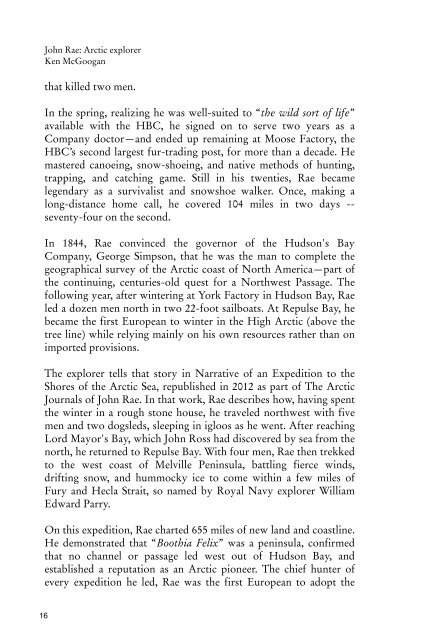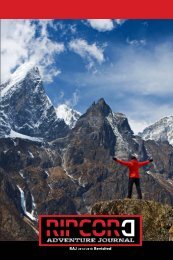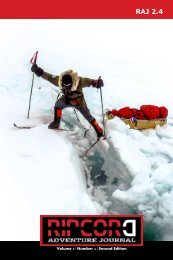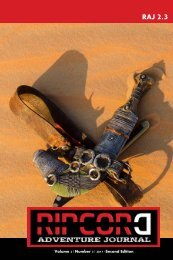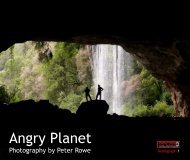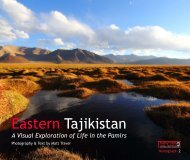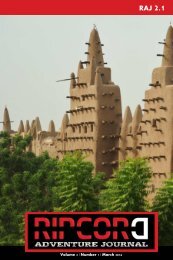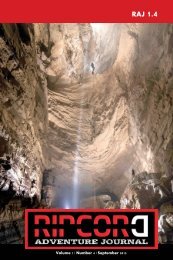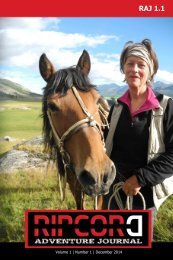Ripcord Adventure Journal 1.3 Second Edition
We begin this issue with a call to adventure from Bear Grylls' Mission Survive expedition and survival expert Megan Hine which is followed by a filmmaking expedition to the icy desert of Antarctica. Our writers have crossed the Himalaya and have cycled around the world to make sure it is indeed round. We hear of legendary explorer John Rae and venture to Kilimanjaro to witness a high altitude rescue. Brought to you by the crew at World Explorers Bureau and Ripcord Travel Protection
We begin this issue with a call to adventure from Bear Grylls' Mission Survive expedition and survival expert Megan Hine which is followed by a filmmaking expedition to the icy desert of Antarctica. Our writers have crossed the Himalaya and have cycled around the world to make sure it is indeed round. We hear of legendary explorer John Rae and venture to Kilimanjaro to witness a high altitude rescue. Brought to you by the crew at World Explorers Bureau and Ripcord Travel Protection
Create successful ePaper yourself
Turn your PDF publications into a flip-book with our unique Google optimized e-Paper software.
John Rae: Arctic explorer<br />
Ken McGoogan<br />
that killed two men.<br />
In the spring, realizing he was well-suited to “the wild sort of life”<br />
available with the HBC, he signed on to serve two years as a<br />
Company doctor—and ended up remaining at Moose Factory, the<br />
HBC’s second largest fur-trading post, for more than a decade. He<br />
mastered canoeing, snow-shoeing, and native methods of hunting,<br />
trapping, and catching game. Still in his twenties, Rae became<br />
legendary as a survivalist and snowshoe walker. Once, making a<br />
long-distance home call, he covered 104 miles in two days --<br />
seventy-four on the second.<br />
AAAAAAAAAAAAAAAAAAAAAAAAAAAAAAAAAA<br />
AAAAAAAAAAAAAAAAAAAAAAAA<br />
In 1844, Rae convinced the governor of the Hudson's Bay<br />
Company, George Simpson, that he was the man to complete the<br />
geographical survey of the Arctic coast of North America—part of<br />
the continuing, centuries-old quest for a Northwest Passage. The<br />
following year, after wintering at York Factory in Hudson Bay, Rae<br />
led a dozen men north in two 22-foot sailboats. At Repulse Bay, he<br />
became the first European to winter in the High Arctic (above the<br />
tree line) while relying mainly on his own resources rather than on<br />
imported provisions.<br />
The explorer tells that story in Narrative of an Expedition to the<br />
Shores of the Arctic Sea, republished in 2012 as part of The Arctic<br />
<strong>Journal</strong>s of John Rae. In that work, Rae describes how, having spent<br />
the winter in a rough stone house, he traveled northwest with five<br />
men and two dogsleds, sleeping in igloos as he went. After reaching<br />
Lord Mayor's Bay, which John Ross had discovered by sea from the<br />
north, he returned to Repulse Bay. With four men, Rae then trekked<br />
to the west coast of Melville Peninsula, battling fierce winds,<br />
drifting snow, and hummocky ice to come within a few miles of<br />
Fury and Hecla Strait, so named by Royal Navy explorer William<br />
Edward Parry.<br />
On this expedition, Rae charted 655 miles of new land and coastline.<br />
He demonstrated that “Boothia Felix” was a peninsula, confirmed<br />
that no channel or passage led west out of Hudson Bay, and<br />
established a reputation as an Arctic pioneer. The chief hunter of<br />
every expedition he led, Rae was the first European to adopt the<br />
16


